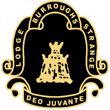
Lodge Burroughs Strange No. 87
Vijayawada, India
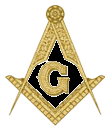

Article on Freemasonry - 74
A Personal Exploration in to the Hidden Mysteries
of
the Holy Royal Arch Chapter
By
E.Comp. Bharat V. Epur
M.E. Grand Superintendent,
Regional Grand Chapter of Eastern India
PZ ñ C 108 (2004), PZ ñ C 107 (2008), PZ ñ C 123 (2008),
PZ ñ C 651 SC (2009), PZ ñ C 33 (2010), PZ ñ C 103 (2013),
SGCI: PGDofC; RGCSI: PIIRGPr; RGCNI: PIIRGPr;
RGCWI: PIIARGSoj; USRAFIC: Hony Grand H.
A Masonic Paper presented
at the Regular Assembly of Acacia - The Madras Masonic Study Circle
on Friday, 31st October 2014
at Freemasons’ Hall,
Chennai.
Respected Chairman of Acacia, M.E.Comp. KM Venkatachalam, dignitaries on and off the dais, M.E. Companions, E. Companions and Companions all!
I thank the Management Committee of Acacia for giving me this opportunity to share some of my thoughts on the Holy Royal Arch, so truly denominated the essence of Freemasonry. When I was “exalted” in Chapter Discovery No.2, SGCI on 2nd March 1999 by none other M.E.Comp. Capt. Dr. B. Biswakumar, PIGP, PG Supdt., who also delivered the Mystical Lecture with his usual panache, it was almost like experiencing an epiphany! When the hoodwink was removed, my eyes fell upon a glorious panoply of colours and shapes - quite unlike anything that I had hitherto experienced. This left an indelible impression on my mind.
Several years have passed since that day! I have attended several hundreds of Royal Arch convocations and have occupied the First Principal’s Chair not once, not twice, but six times! I must have helped “exalt” several dozens of candidates. Despite this, the charm that this Order has over me has not diminished. If anything, it has only increased! This is so because of the truly exalted mysticism and philosophy ingrained in every part, point and letter of its ineffable mysteries.
A Masonic Paper by Bharat V. Epur on the Holy Royal Arch
I shall, in this Paper, attempt to expound on some of these hidden mysteries so beautifully interwoven into this Order. This Paper is by no means a treatise or the definitive work on the subject. It is merely an attempt by an awe-struck Companion to understand, appreciate and explain some but not all of its inherent verities.
Before I proceed any further, I would like to quote from the Masonic savant, W.Bro. WL Wilmshurst, who in his book “The Meaning of Masonry” said: “The higher degrees indeed illustrate truths of much interest and often set forth with impressive ceremonial beauty, the appreciation of which will be the greater after and not before the meaning of the preliminary ones have been thoroughly absorbed: whilst the pursuit of ‘Secrets’ is certain to prove illusory, for the only secrets worth the name or the finding are those incommunicable ones which discover themselves within the personal consciousness of the seeker who is in earnest to translate ceremonial representation into facts of spiritual experience.”
As a preamble, let me remind you of four distinct features of the Holy Arch that distinguish it from the three preceding Grades leading to it.
First, no one can be received into the Holy Royal Arch without first having attained the ranks of a Master Mason.
Second, the letter “G” symbolizing the GGOTU, which in the Second Degree shone high above in the ceiling of the Temple, to which the Fellow Craft’s attention would have been drawn at the end of the Explanation of the Tracing Board, has moved downwards in the Third Degree and burned as the source for the glimmering ray in the East to guide the candidate to the Light of a Master Mason - darkness made visible; has now descended completely to the chequer-work floor, where it rests as the centre and cubicle focus and bears the Sacred and Mysterious Name of TTALGMH, as also those of Solomon and the two Hirams.
Third, the constitution of the Assembly is no longer of seven officers, but of nine, who are grouped in three triads.
Four, the Assembly regarded as a unity, is no longer designated a Lodge, but a Chapter.
Let us take a brief look at each of the above.
The first of the above points can be explained thus. It is an indisputable fact that no one who has not experienced the stage of mystical death can experience that which lies beyond that death. As Wilmshurst put it: “As an unborn physical infant can know nothing of this world, in which nevertheless it exists, until actually initiated into it by birth, so the embryonic spiritual child cannot be born into conscious function upon the plane of the Spirit until it has become entirely detached from the enfolding carnal matrix and tendencies to which it has been habituated.” Thus, it is imperative that only a Master Mason can qualify for exaltation into the Holy Royal Arch, and that too after sufficient time spent as a Master Mason to meditate on the teachings of that Degree.
The descent of the letter “G”, as referred to in the second point, and the re-arrangement of
the ceremonial Temple, as referred to in the third point, are symbolic of the candidate’s own psychical reorganization. The Light that shone in the ‘Heavens’ first descended to illuminate ‘his dormer window (or, his natural intelligence), then descended further below to ‘visit’ him, i.e., the source of all consciousness has descended into his very transient physical organism
and thus ‘exalted’ him. God has become man! Man has become divinized! In Masonic terms, the Vital and Immortal Principle resident in the candidate has at last succeeded in superseding his temporal Life-Principle and established him upon a new centre of incorruptible life. That new centre is described as the GGOTU.
Thus, the new candidate is symbolized by an equilateral
triangle with a point at its centre. This triangle signifies the tripartite aspects of this Companion (his spiritual, psychical and physical parts) all equalized and equilibrated around their common Life-Principle at the centre, fitted and equipped for its purpose. Each of these three divisions though itself unitary, is philosophically triadic in composition. Hence, each of these three sides of the equilateral triangle has three aspects, which are ceremonially personified by the nine Officers of the Chapter - three in the East representing the spiritual side, three in the West figuring the soul or psychical side, and three subordinate links connecting the other two.
The fourth point refers to the re-designation from “Lodge” to “Chapter”. The word ‘Chapter’ derives from ‘Caput’, meaning head. This is in allusion to the candidate sublimating his lower nature to his spiritual self and achieving union with the Universal Spirit, thus ascending to the capitular rank and consciousness of the Arch Mason himself.
At this time, let me digress for a moment on the mathematical figure of the triangle, which assumes significance in this Order. We see it on the sceptres of the Three Principals, on the jewels of all the Officers, on the aprons and the sashes, in the layout of the three greater and
the three lesser lights, the top of the altar, and so on. In the Mystical Lecture our attention is drawn to this mathematical figure as being of major significance. I shall not expand on this symbol any further in this Paper as that would entail a separate Paper in itself. I shall, however, limit myself to a few observations only.
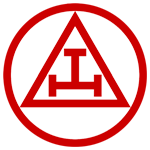
Royal Arch Masons
Now let us take a brief look at the main sign used in this Order - the reverential or hailing sign! The penal signs of the preceding three degrees of the Craft - representing the guttural, pectoral and abdominal - may be correlated to three of the chakras in the human body, namely ‘Visuddha’ (the thyroid gland), ‘Anahata’ (the thymus gland) and ‘Manipura’ (the islets of Langerhans in the pancreas and the adrenal glands), respectively. The reverential or hailing sign in the Royal Arch can, in a similar manner, be correlated to the ‘Sahasra’ chakra, the pituitary gland. Thus, even the sign of the Degree refers to that part of the human body that may be considered the control point for ‘exaltation’ of mere mortal in to a more developed soul.
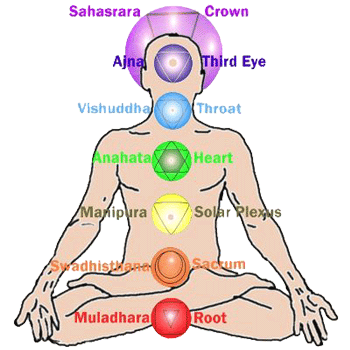
The Chakras in the Human Body
Before we examine the Ceremony of Exaltation itself, let us take a look at the Opening of the Chapter and at the layout of the Temple. At the opening of the Chapter, the Three Principals form, with their left hands, a basal triangle, with its apex pointing to the East. Then the Scribe Nehemiah places the Volume of Sacred Laws above it. The Three Principals then cover it with their right hands, again in the form of a triangle - this time the spiritual triangle, with its apex pointing to the West. This may be interpreted as the Three Principals transcending from the basal plane onto the spiritual plane with the assistance of the Volume of Sacred Laws. In other words, with the assistance of Faith, as represented by the Volume of Sacred Laws, they are ‘exalted’. This is, in many ways, similar to the symbolical representation in the Tracing Board of the First Degree, wherein the Mason’s symbolic ascent to the celestial canopy of heaven is
by means of the Jacob’s ladder, which rests on the Volume of Sacred Laws, with the first rung representing Faith.
Thus, when the triangle of the spiritual plane is superimposed on that of the physical, we get the six-pointed star - the hexagonal star. This is well-known to us as one of the most potent of all Masonic symbols - the Shield of David or the Seal of Solomon. It can also be considered a compound representation of the four elements - water, earth, air and fire - culminating in
the fifth element compromising all these four. This study of this symbol is yet another area that can be the subject of its own Paper. I shall confine myself to bringing to your attention that
this formation is made at the closing of the Chapter by Three Principals, and, again in the Conclave of Installed First Principals. It is an unfortunate truth that almost 99% of the Installation ceremonies that I have witnessed, this important aspect is totally missed, inevitably because of ignorance of the correct way of communicating the sign in question to the First Principal Designate/ Elect by the Installing First Principal. As some of Companions present
here this evening are not Installed First Principals, I shall not amplify this anymore. I am, however, willing to discuss this later at any individual level with duly qualified Companions.
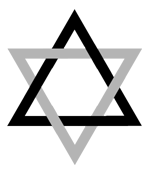
Shield of David
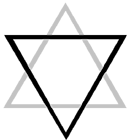
Water
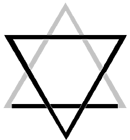
Earth
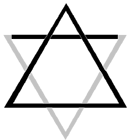
Air
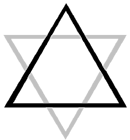
Fire
Once the Three Principals complete their respective opening ceremonial working in the West, they proceed to the East by taking the symbolic seven steps, halting and bowing at the third, fifth and seventh step, approaching nearer to the Sacred and Mysterious Name of TTALGMH. Later in the Ceremony of Exaltation, the candidate is coached to proceed from the West to the East in the same manner, albeit without giving the sign. These steps may serve as reminders to the Companions of the steps taken in the preceding Craft Degrees.
Once the Three Principals reach the East, they form a series of triangles - four in number - to exchange the Sacred and Mysterious Name of TTALGMH, thus referring to one of the oft-recurring numerical themes in the Royal Arch - namely, three, four, five, seven, nine (3 x 3) and twelve (3 x 4).
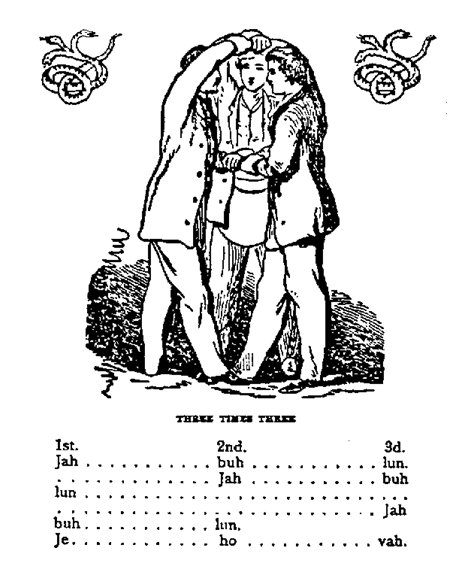
I have already dealt with the number three. Let me now amplify on the number four. Apart from the four knocks of the Degree, we have the four Principal banners of a lion, an ox, a man and an eagle. They derive from a very ancient glyph, declaring, among other things, the story of soul’s evolution and its progress from the passional wild beast stage to one which, while still sensuous and animal, is docile and disciplined for service, and thence to the stage of human rationality, which at length culminates in upward-soaring spirituality. I now draw your attention to that most historic and unique of all monuments of Ancient Egypt - the Sphinx, which is nothing but a perfect amalgam of all four of these manifestations - the body of a lion, the hooves and feet of an ox, the face of a man and the wings of an eagle!
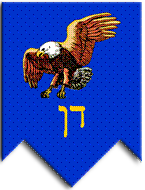
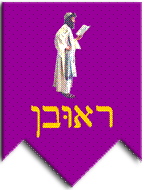
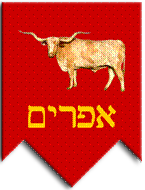
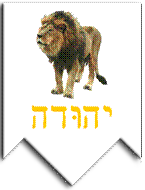
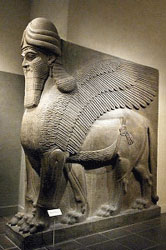
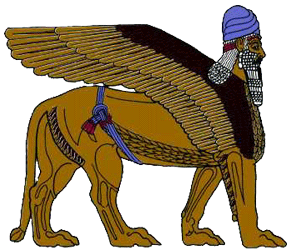
One of the most significant items of furniture in a Chapter are the Platonic Bodies - five in number - the only regular polyhedrons, each referring to one of the five elements viz. the tetrahedron (with four sides - consists of four triangles equalling eight right angles, i.e. one Triple Tau - representing Fire - red in colour), the octahedron (eight sides – consists of eight triangles equalling sixteen right angles, i.e., two Triple Taus - representing Air – blue in colour), the hexahedron - also known as the cube (six sides - consists of six squares equalling twenty-four right angles, i.e., three Triple Taus - representing Earth - white in colour), icosahedron (20 sides - consists of twenty triangles equalling forty right angles, i.e., five Triple Taus - representing Water - purple in colour) and the dodecahedron (12 sides - consist of twelve pentagons equalling seventy-two right angles, i.e., nine Triple Taus - representing no the sphere of the Universe as often wrongly mentioned, but as explained by Plato himself, an astral element uniting Heaven and Earth, permeating the whole sphere of the Universe and purging the material elements of their baser elements). I do not wish to dilate any further on the Platonic Bodies or the Triple Tau in this Paper. [Please note that the number seventy-two mentioned in this paragraph also has great significance, which perhaps can be the subject of yet another Masonic paper!]
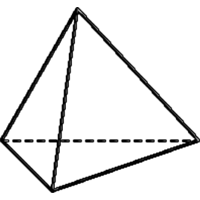
Tetrahedron
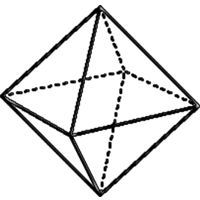
Octahedron
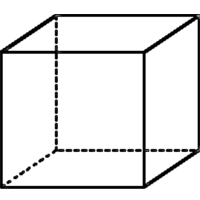
Cube
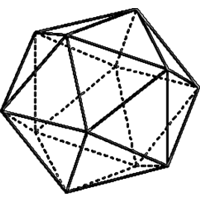
Icosahedron
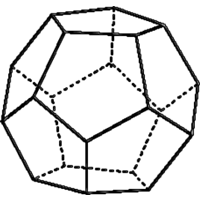
Dodecahedron
I have already touched upon the number seven. Let me direct your attention to another instance of the number seven’s importance. When the candidate is raised in due form with the grip of a Royal Arch Mason by the Principal Sojourner and his hoodwink is removed, his eyes take in an awe-inspiring spectacle. He sees a serried of colourful ensigns supported on staves – six on either side – held at ever increasing acute angles to the floor, with each set of two – one on either side – almost approximating a triangle. This naturally directs his attention to the centre where the Three Principals are placed side-by-side holding their sceptres in the form of the seventh and final triangle! Thus, the candidate’s attention is symbolically directed to the seven arches of the seven vaults – the same under which was the long-hidden home of the Lost World!
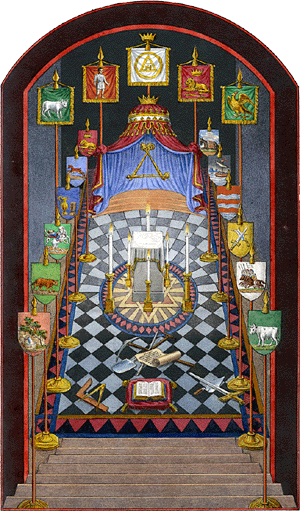
The candidate also sees the Platonic bodies, six lights, implements of labour, sword and trowel besides other items of furniture. I have already discussed the first of these: the others I shall leave for another occasion.
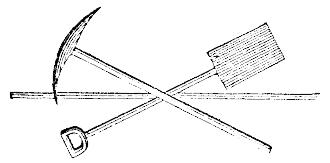
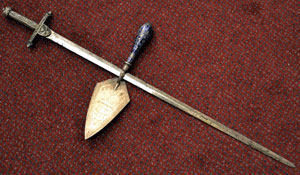
In this connection, I would like to bring to your notice that the positioning of the sword and the trowel are more often than not incorrect in most Royal Arch Chapter settings. The correct way is for the sword to be placed on the left hand side and the trowel on the right. This is reflective of the fact that the original re-builders of King Solomon’s Temple, who had returned from captivity in Babylon, were engaged in the building of the Temple with the trowel in their right hands. They also carried swords in the left hands, ever-ready to defend themselves and their work from the attacks of their enemies from among the surrounding tribes. It is for this reason that the sash of the Royal Arch Mason is worn over the left shoulder and under the right arm, thereby enabling the sheathing of one’s sword on the right side of the body allowing easy access with the left hand.
While on the subject of the left hand and the right hand, allow me to digress further. You will recall that when the Sojourners were sent to prepare the ground for the Second Temple on the site where the First formerly stood, they came across a compact piece of masonry wrought in the form of a dome. On descending into the vault below, one of them picked up something like a scroll of vellum or parchment. His right hand was thus engaged leaving only the left hand free to shield his eyes from the brightness of the divine presence that he, after unveiling the altar, beheld on a dazzling plate of gold and humbly conceived to be the sacred and mysterious name of TTALGMH. It is in continuation of this themes that the penal sign in this Degree is given with the left hand. So also, the Royal Arch Companion is expected to use his left hand while signifying his assent in all votes and resolutions in the Chapter.
Let me now move on to the number nine. I had mentioned earlier in my Paper about the three triads of Officers totalling nine. Let us explore this a little more.
The triad of Officers in the East is comprised of the Three Principals, signifying the spiritual pole; the triad in the West consists of the three Sojourners, signifying the psychic and materialized pole.
The Spirit in man in its triple aspects is typified by the Three Principals representing the three highest attributes of the Spirit – Holiness, Royal Supremacy, and Functional Power – referred to in the title of the Order; Holy – Royal – Arch. The middle is the neutral term – anthropomorphized as Zerubbabel – and occupies centre-stage between a passive (Haggai), or a negative, and, an active (Joshua), or a positive aspect; all three acting conjointly and as one, as is, in fact, the case with the Three Principals. Zerubbabel literally means “a spouting forth from Babel, or from among the people”. Zerubbabel represents the loftier element differentiated from others. He is a ‘Prince’ of his ‘people’. He reminds us of the omnipotence of the Father of All. This is the reason for the reference to ‘Royal’ in the title. Haggai the Prophet represents the passive aspect and signifies at once the blissful and self-contemplative nature of the Spirit. It is called ‘the Prophet’ because of the power of insight and omniscience characterizing that which transcends the sense of time. From the same word is derived the Greek word ‘hagios’, or Holy. Joshua, the son of Josedech, the High Priest personifies the active executive aspect of Spirit. Literally Joshua means the ‘divine saviour’, and Josedech ‘divine righteousness’, whilst the High Priest connotes a mediatorial factor between man and Deity. Thus, the title in its entirety intimates that the human spirit or divine Principle in man functions omnipotent but intermedially between the Deity and man’s lower nature to promote the latter’s salvation and perfection.
The triad of Sojourners in the West represent the unitary human Ego or personality, again in its threefold aspect. They are the physical aspects of the baser elements of man. Hence they are designated as Sojourners, in reference to their transitory nature as wayfarers upon a plane if impermanence. Once again, each of these three represents an aspect of the triune. The Principal Sojourner represents the Ego with its central and directive power of will. The two Assistant Sojourner represent sub-consciousness, with its passive intuitive capacity, and, practical intelligence, with its active and connecting powers of thought and understanding.
The nexus or interconnecting medium between man’s spiritual and bodily poles is represented by the Scribes and the Janitor. The more important of the two Scribes, namely Ezra is attached to the East pole and acts as its emissary to the West; the other, namely Nehemiah is associated with the West and his activities are directed to the East; whilst the Janitor is the point of contact with the world without. In the Ancient Egyptian mystery schools, the archetype of Hiram Abiff was Osiris. In Hebrew this name got transformed into Azarias, and, then got further corrupted to Esdras and Ezra. Ezra and Nehemiah personify two distinct stages of the mystical progress made by the candidate.
Let us now take a quick look at the occurrence of the number twelve. The twelve ensigns represent the twelve tribes of Israel, and, are, themselves, prototypes of the twelve zodiacal sections of the heavens that always exist and are only discernible to those who can see with their inward eye. The floor-carpet in the Royal Arch has further allusions to the Zodiac. Additional references to this number twelve in the Royal Arch are the twelve labours of Hercules and the Christian tradition of the twelve Apostles of the Great Exemplar.
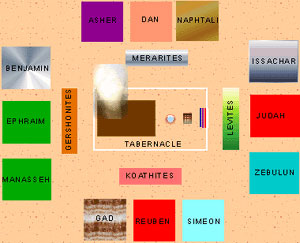
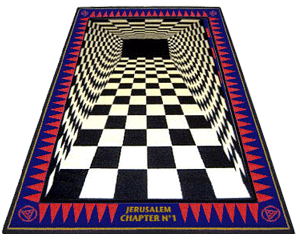
Let us now take a quick look at the Ceremony of Exaltation itself. The Royal Arch is the natural conclusion and fulfilment of the Third Degree. The Master Mason Degree may be said to exemplify the Christian theological doctrine “He suffered and was buried and rose again”, whilst the equivalent of the Exaltation ceremony is “He ascended into Heaven”.
The Password leading to this Supreme Degree that the candidate has to be in possession of before his Ceremony of Exaltation can commence, I daresay you recollect is “A..R…”, which is interpreted as “My people having found mercy”. What does this mean in the context of this paper? As Wilmshurst explains: “It signifies that all the parts and faculties (‘people’) of the candidate’s organism have at last, and as a result of his previous discipline and ordeals, become sublimated and integrated in a new quality and higher order of life than that previously enjoyed in virtue of his temporal nature”.
After the candidate conveys the Password, he is brought into the Chapter – once again in a state of darkness. But the reason for this darkness differs entirely from that which existed in the Entered Apprentice Degree. In the latter, he was but an ignorant beginner on a quest. Now he has long passed beyond that stage; he is now fully equipped with all the qualifications of a Master Mason. At his Initiation he discovered it, only to lose it in the Third Degree, during which he learned to draw strength from weakness by using the Vital and Immortal Principle within him, in whose presence the darkness and the light were alike. The darkness in the Royal Arch is the darkness of the Third Degree carried over. This darkness typified only a momentary failure on his part to adjust his perception of the new life he is about to embark upon. For a while, but only for a brief while, the candidate feels himself in darkness; but he is really blinded rather by the excess of light than by the lack of it. He now walks worthily in the Light that shines around.
In this condition he opens out a certain place which he proceeds to enter and explore, keeping in touch meanwhile with his Companions by a cord or a life-line. This act is pregnant with symbolism. The obstruction once removed by him, the psychical organism becomes detached from the physical and the mind becomes free to introvert and explore within. It is in this state that the introverted mind, groping for its own foundation and centre, reaches the bedrock of its being. This is symbolized by the discovery of the Lost Word, the divine root of its being, from which it has hitherto been so long disassociated.
Thus, this work of the introverted mind and the discovery it makes are shown taking place Amid subterranean gloom in a dark place. It only remains to extrovert this knowledge so that what the Spirit and the Soul already know interiorly, the outer mind may also know exteriorly. This extroversion is symbolically achieved by the return of the candidate from the subterranean depths to the surface and there re-joining his former Companion-Sojourners. It is then that the Mystery is consummated. The Vital and Immortal Principle comes to self-consciousness in him. The condition may be considered equivalent to ‘Samadhi’ or beatific vision.
He has passed through the ark of redemption and entered into the mansions of everlasting bliss and glory, into the presence of Him who is the great I AM, the Alpha and Omega, the Beginning and the End, the First and the Last; who WAS and IS, and IS TO COME.
AMEN! AMEN! AMEN! AMEN!
- Wilmshurst WL: “The Meaning of Masonry”
- Supreme Grand Chapter of India: Ritual Book on the Royal Arch Chapter
- Various Internet Sources
